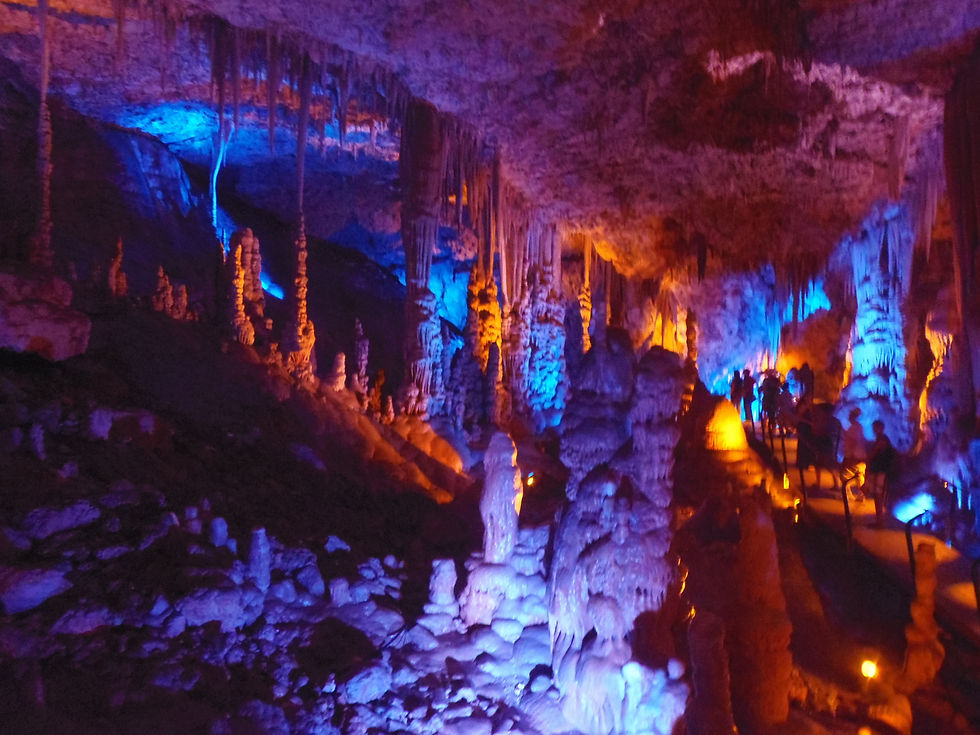Soreq Cave (מערת שורק)
- Mike Levitt

- Jul 7, 2015
- 2 min read
On the western side of Mt.Ye'ela, in the Judean hills, near Hartuv, 3 km east of Bet Shemesh, Israel's most impressive cave was discovered, accidentally, in May 1968, by Alex Schoenberg, while quarrying with explosives at the Hartuv Quarry. Variously known as Avshalom Cave (מערת אבשלום), after Avshalom Shoham, an Israeli soldier killed in the War of Attrition, Soreq Cave (מערת שורק), after the Nahal which it overlooks, and Stalactites Cave (מערת הנטיפים), it is a 5,000 square metre cavern unique both scientifically and touristically for its dense concentration of stalactites. The cave is 83 m long, 60 m wide, and 15 m high.
Later Alex Schoenberg described the feeling a 'sense of Genesis, where the human foot had never set ." Not sure what reaction he would receive, Schoenberg advised the quarry management that the cave should be preserved, quarrying there stopped, and the authorities informed about the discovery.
After its discovery, the location of the cave was kept a secret for several years for fear of damage to its natural treasures. It was opened in 1975 to the public. The temperature and the humidity in the cave are constant year round, and in order for it to remain open to visitors, its atmosphere is constantly monitored and kept in check. Some of the stalactites found in the cave are four meters long, and some have been dated as 300,000 years old. Some meet stalagmites to form stone pillars, whilst others form impressive sheet formations.
In 2012, a new lighting system was installed, which most visitors think is for theatrical effect due to its changing colours, but which is actually designed to prevent the formation and growth of algae. Glowing amber spotlights fade into midnight blue mixed with circles of emerald, programmed to change every few minutes. The colors were selected as part of a decades-long ecological battle to keep the cave's stalactites and stalagmites as pristine as possible. By using only a limited part of the color spectrum, avoiding shite light, photosynthesis is avoided, and hence algae kept at bay.

Me'arat Shimshon (Samson's Cave), on the opposite side of Nahal Soreq to the cave. Nahal Soreq is mentioned in the Book of Judges 16:4 as the border between the ancient Philistines and the Tribe of Dan. It was the place where Delilah lived, and Samson came to meet her for the first time. It was also the place she enticed him to tell her the secret of his strength, and where he was eventually captured by the Philistines.

Descending to the cave: Yonatan and Saba Moshe.










Almost touching! Just another 1,000 years!






Above: intrepid explorers through three generations: Moshe, Riva and Yonatan!
Near the summit of Mount Ya’ale, this metal elliptical sculpture depicting the earth is in memory of the space shuttle, Challenger astronauts that perished shortly after lift-off (picture below). The 1987 sculpture by Eli Ran is called "Holding Point" (נקודת אחיזה). Nearby is a plaque commemorating the Israeli astronaut, Ilan Ramon, who perished with the crew of the Columbia spacecraft, but we didn't see it this time.



Comments